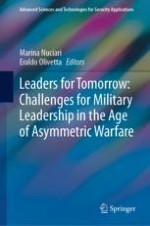2021 | OriginalPaper | Chapter
The Rules of Engagement. An Essential Tool in Need of Improvements
Author : Rafael Martínez
Published in: Leaders for Tomorrow: Challenges for Military Leadership in the Age of Asymmetric Warfare
Publisher: Springer International Publishing
Activate our intelligent search to find suitable subject content or patents.
Select sections of text to find matching patents with Artificial Intelligence. powered by
Select sections of text to find additional relevant content using AI-assisted search. powered by
